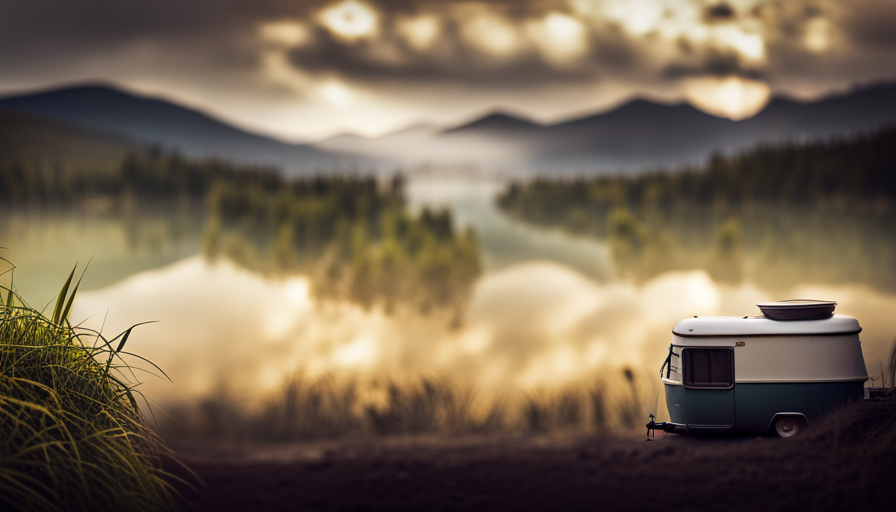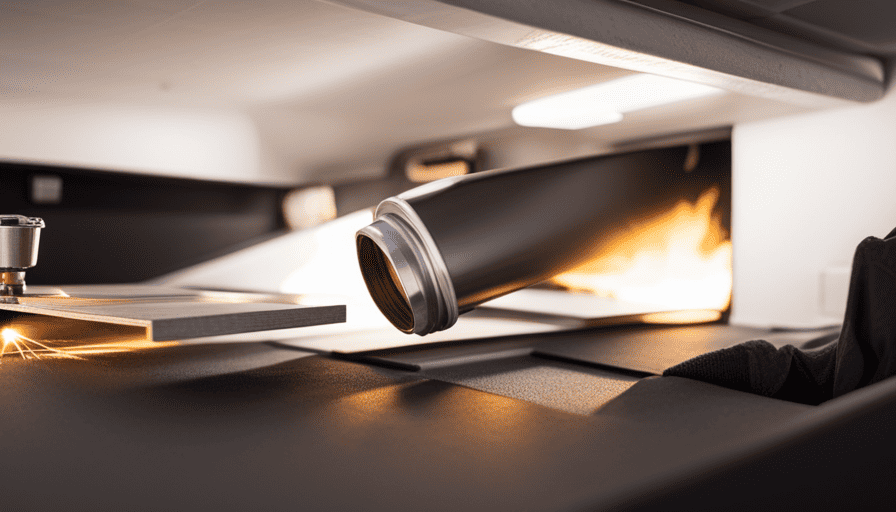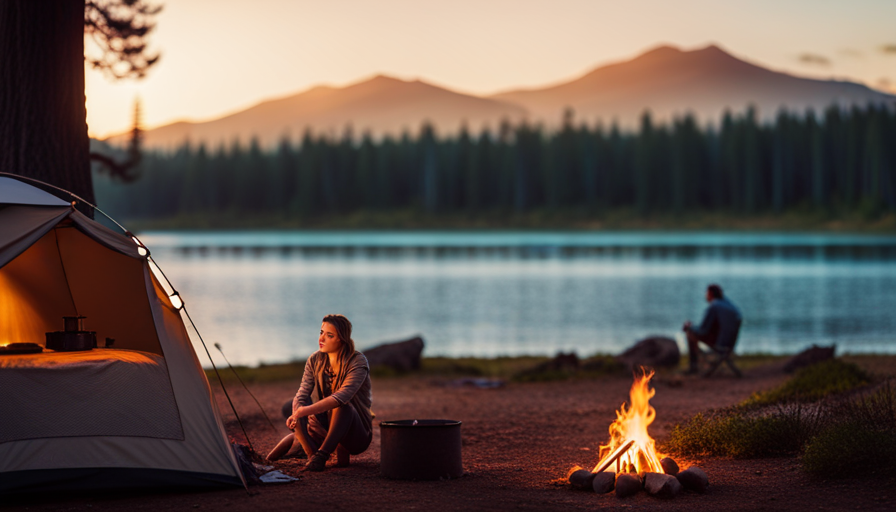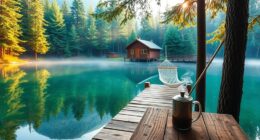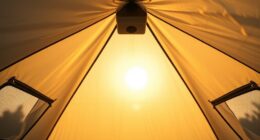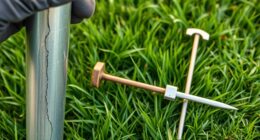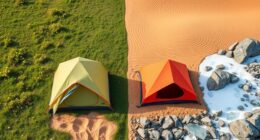Picture yourself embarking on a road trip, with the flexibility to discover new places at your own speed. A camper van could be the key to living a nomadic life, providing a great balance of convenience and coziness.
But before embarking on this exciting adventure, it’s essential to understand the financial commitment involved. In this article, we will delve into the average cost of a camper van, shedding light on the various factors that influence prices. From small to large camper vans, we’ll explore the price ranges you can expect to encounter.
Additionally, we will discuss the additional costs to consider, financing options available, and the pros and cons of owning a camper van. Whether you’re contemplating buying or renting, this article will equip you with the knowledge you need to budget for your camper van adventure.
So buckle up and let’s dive into the world of camper van costs!
Key Takeaways
- Camper vans come in different sizes and types, and factors such as age, condition, brand, and amenities affect their prices.
- Small camper vans typically range from $20,000 to $40,000, while medium camper vans can cost between $40,000 to $60,000, and luxury options can reach $80,000 to $120,000.
- Large camper vans can be purchased new or used, with popular brands like Mercedes-Benz, Winnebago, and Ford. New large camper vans have higher prices but offer warranties and customization options, while used options provide cost savings but may require more maintenance.
- In addition to the purchase price, camper van owners should consider additional costs such as insurance, registration fees, maintenance, and camping/park fees. Insurance rates vary, registration fees depend on the state/country, and maintenance costs can range from $1,000 to $3,000 annually. Camping and park fees vary based on location and amenities.
Factors Affecting Camper Van Prices
When it comes to camper van prices, there’s a multitude of factors that can influence the average cost. Understanding these factors affecting camper van prices can help you make an informed decision and find an affordable option.
The first factor to consider is the size and type of camper van. Small camper vans tend to be more affordable compared to larger ones. Additionally, the age and condition of the camper van play a significant role in determining its price. Older models or those in need of repairs may be priced lower.
Another factor to consider is the brand and popularity of the camper van. Well-known brands often come with a higher price tag due to their reputation and quality. Additionally, the features and amenities included in the camper van can impact its price. Luxurious amenities, such as a fully equipped kitchen or a bathroom, may increase the cost.
When searching for affordable camper vans, it’s recommended to consider these factors and prioritize based on your needs and budget.
Now, let’s delve into the average price range for small camper vans.
Average Price Range for Small Camper Vans
In the realm of small camper vans, prices tend to fall within a certain range. When considering the average price range for small camper vans, it’s important to take into account factors that affect resale value. These factors include the age of the vehicle, its overall condition, and the brand reputation. Additionally, budget-friendly modifications can also impact the price range of small camper vans. These modifications may include adding solar panels, upgrading the interior, or installing a pop-top roof.
First, the age of the vehicle plays a significant role in determining its price range. Older models generally have a lower price tag compared to newer ones due to depreciation.
Second, the overall condition of the camper van affects its value. Well-maintained vans with minimal wear and tear tend to command higher prices.
Third, the reputation of the brand can influence the price range. Popular brands with a strong following often come with a higher price tag.
Considering these factors, the average price range for small camper vans typically falls between $20,000 and $40,000. This range provides options for those seeking an affordable camper van without compromising on quality. While the cost of camper vans can certainly be a significant investment, many people find that the convenience and flexibility they provide make them well worth the price. In addition, the versatility of small camper vans allows for easy maneuverability and makes them a practical option for solo travelers or small families. Overall, the overall cost of camper vans can vary depending on individual preferences and budgets, but with the average price range falling between $20,000 and $40,000, there are options available to suit a range of needs. When considering camper van prices, it’s important to factor in additional costs such as insurance, maintenance, and fuel. However, many owners find that the cost of ownership is outweighed by the freedom and adventure that comes with traveling in a camper van. Ultimately, the initial investment in a small camper van can lead to countless memorable experiences and a lifetime of travel opportunities.
Moving on to the next section, let’s explore the average price range for medium camper vans.
Average Price Range for Medium Camper Vans
Medium-sized camper vans typically fall within a price range of $40,000 to $60,000, providing a wider range of options for those looking for a slightly larger and more spacious camping experience. When considering the factors affecting resale value, it’s important to note that the make, model, age, condition, and mileage are key considerations.
Luxury camper vans, which offer higher-end features and amenities, tend to have a higher price range. These vehicles often range from $80,000 to $120,000, providing a more luxurious and comfortable camping experience. The additional features and high-quality materials contribute to the higher price tag. However, it’s worth noting that luxury camper vans can also experience a higher rate of depreciation, so buyers should keep this in mind when considering their investment.
Moving forward to the next section discussing the average price range for large camper vans, it’s important to consider the needs and preferences of individuals or families who require more space and amenities for their camping adventures.
Average Price Range for Large Camper Vans
When it comes to large camper vans, there are a few key points to consider: new vs. used options and popular brands.
In terms of buying new or used, it’s important to weigh the pros and cons. While a new large camper van may come with the latest features and warranties, a used one can offer significant cost savings.
As for popular brands, some of the top contenders in the large camper van market include Mercedes-Benz, Winnebago, and Ford. These brands are known for their reliability, spacious interiors, and quality craftsmanship.
New vs. Used Large Camper Vans
Large camper vans, whether new or used, provide the perfect combination of spaciousness and comfort for adventurous road trips.
When considering new vs. used camper van prices, there are some factors to take into account. New camper vans generally have a higher price tag due to their pristine condition and updated features. On the other hand, used camper vans can offer significant cost savings, especially if they are a few years old. However, they may require more maintenance and repairs in the long run.
Pros of buying a new camper van include the peace of mind that comes with a manufacturer’s warranty and the ability to customize the vehicle to your liking. On the other hand, purchasing a used camper van allows you to potentially get a higher-end model at a lower price.
Consider your budget and priorities when deciding between new and used.
Now let’s move on to popular brands for large camper vans.
Popular Brands for Large Camper Vans
One look at the road and you’ll likely spot one of the big names in the camper van industry: Winnebago, Airstream, or Volkswagen. These popular brands are known for their quality and reliability.
When it comes to accessorizing your camper van, there are a few must-haves that many owners swear by. Some popular accessories include solar panels for off-grid power, bike racks for outdoor adventures, and awnings for shade and shelter.
In addition to these accessories, there are also several reputable companies that specialize in camper van conversions. These companies take a standard van and transform it into a fully-equipped camper van with all the amenities you need. Some of the best camper van conversion companies include Sportsmobile, Outside Van, and VanDOit.
Now, let’s move on to the next section and talk about additional costs to consider when purchasing a camper van.
Additional Costs to Consider
When considering the cost of owning a large camper van, there are several additional expenses to take into account.
First, insurance and registration fees can add up significantly. It’s important to research and compare different insurance options to ensure the best coverage at the most affordable price.
Additionally, maintenance and upkeep expenses should be factored in, as regular servicing and repairs can be costly.
Finally, camping and park fees should be considered, especially if you plan on using your camper van for recreational purposes. These fees vary depending on location and amenities, so it’s important to budget accordingly.
Insurance and Registration Fees
Purchasing a camper van involves considering the emotional impact of insurance and registration fees. When it comes to insurance coverage, it’s important to compare costs and policies from different providers. The average cost of insuring a camper van can vary depending on factors such as the make, model, age, and usage of the vehicle. Additionally, insurance rates can also be affected by the driver’s age, driving history, and location. It’s advisable to obtain multiple quotes and review the coverage options to find the best fit for your needs.
In terms of registration fees, these can also vary depending on the state or country in which you reside. Some states may charge a flat fee while others may base it on the weight or value of the camper van. It’s important to research the specific requirements and costs in your area. Considering these factors, it’s necessary to plan for insurance and registration fees when budgeting for a camper van.
Moving on to the next section about maintenance and upkeep expenses…
Maintenance and Upkeep Expenses
Taking care of a camper van is like tending to a delicate garden, requiring regular attention and financial nurturing. When it comes to maintenance costs, it’s important to factor in both routine upkeep and potential repairs.
On average, annual maintenance expenses for a camper van can range from $1,000 to $3,000, depending on the age, make, and model of the vehicle. These costs include regular oil changes, tire rotations, and fluid checks, as well as any necessary repairs or replacements for components such as brakes, batteries, or electrical systems. Additionally, long-term ownership expenses should be considered, such as the need for new tires every few years or the eventual replacement of major components like the engine or transmission. Proper maintenance not only ensures the longevity of the camper van but can also prevent costly breakdowns during your travels.
Transitioning to the next section, camping and park fees can also be a significant consideration when budgeting for your camper van adventures.
Camping and Park Fees
Now let’s talk about camping and park fees, which are an important aspect to consider when calculating the average cost of owning a camper van. As avid campers ourselves, we understand that these fees can quickly add up and impact your overall expenses.
When planning for your camping trips, it’s important to factor in not only the cost of the camper van itself, but also the fees associated with staying at different camping grounds and parks. Here are some key points to keep in mind:
-
Camping gear essentials: Investing in high-quality camping gear is crucial to ensure a comfortable and enjoyable experience.
-
Best camping spots: Researching and choosing the right camping spots can help you find affordable options that offer great amenities and beautiful surroundings.
-
Park fees: Some parks may charge entrance fees, camping fees, or additional fees for amenities such as showers or electricity.
-
Seasonal variations: Be aware that camping fees can vary depending on the season, with peak times typically being more expensive.
Considering these factors will give you a better understanding of the overall cost of owning and using a camper van.
Now, let’s move on to the next section and explore some tips for finding affordable camper vans.
Tips for Finding Affordable Camper Vans
When it comes to finding affordable camper vans, there are a few key tips that can help us make the best decision.
First, it’s important to thoroughly research and compare prices from different sellers to ensure we’re getting the best deal.
Additionally, considering alternative options such as buying used or renting can also help us save money.
Lastly, negotiating with sellers can often lead to lower prices, so it’s worth exploring this option as well.
By following these tips, we can find an affordable camper van that meets our needs and budget.
Researching and Comparing Prices
To find the best deal on a camper van, start by researching and comparing prices, so you can score the average cost that fits your budget.
When researching, it’s important to consider the average price range for camper van models. This can give you a general idea of what to expect. Keep in mind that factors such as age, condition, and features can affect the price.
To compare prices, visit different dealerships, check online listings, and attend camper van shows or auctions. Create a spreadsheet or list to organize the information you gather, including the make, model, year, and price of each camper van you come across.
By carefully researching and comparing prices, you can make an informed decision and find a camper van that meets your needs at the right price.
When considering alternative options, you can explore renting or leasing a camper van, as well as looking into used camper van marketplaces.
Considering Alternative Options
If you’re open to exploring other possibilities, you might want to consider rental or leasing options as well as browsing through used marketplaces for camper vans. These alternative financing methods can provide a more affordable way to enjoy the camper van lifestyle without the commitment of purchasing a brand new vehicle.
Renting or leasing allows you to experience the joys of camper van travel without the upfront costs and long-term financial obligations. Additionally, browsing through used marketplaces can present a wide range of options at lower price points compared to buying new.
Another option to consider is DIY conversions, where you can transform a regular van into a camper van yourself. This can be a cost-effective way to create a customized camper van that suits your specific needs and preferences.
By exploring these alternative options, you can potentially find a camper van that fits your budget and lifestyle.
Now, let’s delve into the next section about negotiating with sellers.
Negotiating with Sellers
When considering alternative options for purchasing a camper van, it’s important to be aware of negotiating strategies and effective communication techniques. These skills can greatly impact the overall cost of the vehicle.
Negotiating with sellers requires a strategic approach, and there are various strategies that can be employed to secure a better deal. One effective strategy is to do thorough research on the market value of the specific camper van model you’re interested in, as well as any potential issues or repairs that may need to be addressed. This knowledge will give you leverage during negotiations and allow you to confidently propose a fair price.
Additionally, effective communication is crucial when negotiating with sellers. Clearly expressing your needs, concerns, and budget can help you find common ground and potentially lower the price. By mastering these negotiating strategies and honing your communication skills, you can maximize your chances of securing a great deal on a camper van.
As we move forward, let’s explore financing options for camper vans.
Financing Options for Camper Vans
When it comes to financing a camper van, there are several options to consider.
Traditional auto loans are a popular choice, offering competitive interest rates and flexible repayment terms.
RV loans specifically designed for financing recreational vehicles are another option, often offering longer loan terms and specialized financing options.
Additionally, personal loans can be used to finance a camper van, providing borrowers with the flexibility to use the funds for any purpose.
Traditional Auto Loans
Traditional auto loans, with their fixed interest rates and predictable monthly payments, can make owning a camper van more affordable for those seeking adventure on the open road. Here are four key benefits of traditional auto loans for financing a camper van:
-
Lower interest rates: Unlike other financing options, traditional auto loans typically come with lower interest rates, saving you money in the long run.
-
Longer loan terms: With traditional auto loans, you can enjoy longer loan terms, spreading out the cost of your camper van over a more manageable period.
-
Flexibility in loan amount: Traditional auto loans offer the flexibility to finance a wide range of camper van models, making it easier to find the perfect fit for your budget.
-
Access to established lenders: Traditional auto loans are offered by established lenders, giving you peace of mind and a reliable financing option.
Transitioning to the next section about RV loans, let’s explore another popular financing option for camper vans.
RV Loans
RV loans can provide more flexibility and convenience for those looking to finance their adventurous road trips. When considering an RV loan, it’s important to research the interest rates offered by different lenders.
RV loan interest rates can vary depending on factors such as the borrower’s credit score, the loan term, and the amount being financed. It’s advisable to compare rates from multiple lenders to ensure you’re getting the best deal.
In addition to interest rates, RV loan requirements may include a minimum down payment, proof of income, and a satisfactory debt-to-income ratio. Meeting these requirements is crucial for obtaining approval.
Now, let’s shift our focus to personal loans, which offer another avenue of financing for those seeking to purchase a camper van.
Personal Loans
Moving on from RV loans, let’s consider another financing option for purchasing a camper van: personal loans. Personal loans can be a viable choice for those who don’t want to use their RV as collateral or prefer a shorter repayment term.
Interest rates for personal loans vary depending on factors such as credit score and lender, but they generally range from 6% to 36%. These loans typically have a fixed interest rate and can be repaid over a period of one to seven years, offering flexibility in terms of repayment. However, it’s important to note that personal loans may have higher interest rates compared to RV loans.
Now that we’ve explored personal loans, let’s delve into the pros and cons of owning a camper van.
Pros and Cons of Owning a Camper Van
One of the best things about owning a camper van is that you can take it anywhere, allowing you to explore new places and create unforgettable memories. The camper van lifestyle offers several advantages and disadvantages that are worth considering.
On the positive side, having a camper van gives you the freedom to travel at your own pace and on your own schedule. It eliminates the need for booking accommodations and allows you to enjoy a sense of adventure and spontaneity. Additionally, camper vans are equipped with various accessories that can enhance your experience, such as portable grills, foldable chairs, and solar panels for sustainable energy. These accessories can make your camping trips more comfortable and convenient.
However, there are also some downsides to owning a camper van. One major consideration is the cost. Camper vans can be quite expensive to purchase, and there are additional expenses such as insurance, maintenance, and fuel. Moreover, owning a camper van requires proper storage and parking facilities when not in use, which can be a challenge depending on your living situation. Another potential drawback is that camper vans have limited space, so it may not be suitable for large families or those who prefer more spacious accommodations.
Owning a camper van has its pros and cons. While it offers the freedom to explore and enjoy the outdoors, it also comes with financial and space limitations.
Now, let’s delve into the topic of renting versus buying a camper van.
Renting vs. Buying a Camper Van
When it comes to exploring the open road, there’s an interesting statistic that might surprise you: renting and buying a camper van have become increasingly popular options for adventure seekers. Whether you’re planning a weekend getaway or a cross-country road trip, camper vans offer a convenient and flexible way to travel.
Here are three advantages of renting a camper van:
-
Flexibility: Renting a camper van allows you to choose the size and type of vehicle that suits your needs. You can easily upgrade or downgrade depending on the number of passengers or the specific features you require.
-
Cost savings: Renting a camper van can be more cost-effective, especially if you don’t plan on using it frequently. You avoid the high upfront costs of purchasing a camper van and the ongoing expenses such as insurance, maintenance, and storage.
-
Variety: Renting gives you the opportunity to try different models and brands. This allows you to test out various camper vans and determine which one is the best fit for your future adventures.
On the other hand, buying a camper van has its disadvantages. Some of the drawbacks include:
-
Higher upfront costs: Purchasing a camper van requires a significant investment upfront. You need to consider the cost of the vehicle itself, insurance, taxes, and registration fees.
-
Maintenance and repair expenses: As an owner, you’re responsible for the maintenance and repair costs of your camper van. These expenses can add up over time.
-
Depreciation: Like any vehicle, camper vans depreciate in value over time. When you decide to sell, you may not recoup the full amount you initially paid.
When considering the cost of a camper van adventure, renting offers advantages such as flexibility, cost savings, and variety. However, buying a camper van comes with higher upfront costs, ongoing maintenance expenses, and potential depreciation.
Transitioning into the subsequent section about budgeting, it’s important to carefully consider your options and create a budget that aligns with your travel goals.
Conclusion: Budgeting for Your Camper Van Adventure
To effectively plan for your upcoming camper van adventure, it’s essential to create a budget that aligns with your travel goals and financial capabilities. Budgeting for a camper van adventure involves considering various factors, such as the cost of the van itself, maintenance and repairs, fuel expenses, campground fees, and other miscellaneous costs.
Here are some budgeting tips and saving strategies to help you make the most of your adventure without breaking the bank.
Firstly, when it comes to purchasing a camper van, consider buying a used one instead of a brand new vehicle. Used camper vans can be significantly cheaper and still provide all the necessary amenities for your trip. Additionally, setting a realistic daily or weekly budget for fuel expenses is crucial. Research the average fuel consumption of your van and estimate the distance you plan to travel to calculate an approximate fuel cost.
Another way to save money is by opting for free or low-cost camping options. Many national parks, public lands, and even some private campgrounds offer affordable or even free camping spots. Take advantage of these options to reduce your campground fees.
Furthermore, planning your meals and cooking in the van can help you save on dining expenses. Stock up on groceries before your trip and utilize the kitchen facilities in your camper van to prepare your own meals.
Budgeting for your camper van adventure requires careful consideration of various expenses. By following these budgeting tips and saving strategies, you can ensure that your trip remains affordable while still enjoying a memorable and fulfilling experience.
Frequently Asked Questions
Are there any additional costs associated with owning a camper van?
There are additional costs associated with owning a camper van, such as the cost of maintenance and insurance.
Maintenance costs for a camper van can vary depending on the age, make, and model of the vehicle. Regular maintenance tasks include oil changes, tire rotations, and inspections.
Insurance costs also depend on various factors, including the driver’s history, location, and the value of the camper van. It’s recommended to budget for these additional expenses to ensure the proper upkeep and protection of your camper van.
What are some tips for finding affordable camper vans?
When it comes to finding affordable camper vans, there are a few tips that can help.
First, consider looking for used camper vans as they tend to be more budget-friendly.
Next, research different sellers and compare prices to ensure you’re getting a good deal.
Finally, don’t be afraid to negotiate for a lower price. By being prepared and knowledgeable about the market value, you have a better chance of securing a more affordable camper van.
What are the pros and cons of owning a camper van?
Living in a camper van can be a liberating experience, like a soaring eagle in the vast sky.
Pros include the freedom to travel anywhere, reduced living expenses, and a closer connection with nature.
However, challenges like limited space, maintenance costs, and the need for proper parking can be cons.
For off-road adventures, some popular camper van models are the Mercedes-Benz Sprinter, Ford Transit, and Volkswagen Crafter.
These models offer durability and versatility for rugged terrains.
Is it better to rent or buy a camper van?
When considering whether to rent or buy a camper van, several factors should be considered.
Renting provides flexibility and convenience, especially for occasional travelers. However, buying may be more cost-effective in the long run, especially for frequent travelers.
A thorough long-term cost analysis is crucial, taking into account factors such as depreciation, maintenance, and insurance.
When making a decision, it’s important to weigh the renting vs. buying considerations and assess the overall financial implications.
How can I budget for my camper van adventure?
When it comes to budgeting for a camper van adventure, there are some key tips that can help us save money along the way. First, it’s important to plan ahead and set a realistic budget for expenses like fuel, campsite fees, and food.
We can also consider options like cooking our own meals instead of eating out, and looking for free or low-cost camping spots. By being mindful of our spending, we can make the most of our camper van adventure without breaking the bank.
Is a Camper Van the Same as a Camper?
Many people wonder, Is a camper van the same as a camper? To answer this question, let me break it down for you. A camper van is a type of camper that is built on a van chassis. It combines the functionalities of a van and a camper, providing compact living quarters for travel and adventure. So, what is a camper explained? It’s a broad term that encompasses various recreational vehicles, including camper vans, motorhomes, and pop-up campers.
Conclusion
Well folks, we’ve reached the end of our journey into the world of camper van prices. After crunching the numbers and analyzing the data, it’s clear that purchasing a camper van is no small investment.
From the factors affecting prices to the average price ranges for small, medium, and large camper vans, we’ve covered it all. And let’s not forget about those additional costs and financing options.
But hey, don’t let the price tag scare you away. With careful budgeting and a little creativity, you can embark on an unforgettable camper van adventure. Happy travels!


